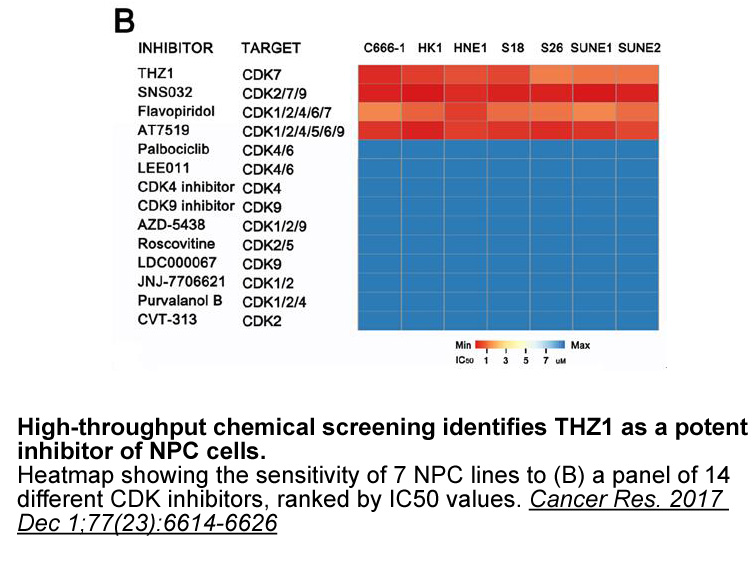Archives
Aberrant expression of HKII may be a required
Aberrant expression of HKII may be a required feature for cancer development and progression. Overexpression of HKII has been reported in tumor tissues of cancer patients with liver [9], ovary [8], [24] and larynx [25]. The clinical significance of HKII in cancer was noted as overexpression of HKII was associated with poor prognosis of the patients, e.g., shorten survival, metastasis and chemoresistance. Clinical significance of HKII in cancer was proved in in vitro and in vivo studies. Knocking down of HKII expression using siRNA significantly suppressed growth of lung cancer cells [26], [27].
The direct evidence that HKII is necessary to promote growth and metastasis of CCA was supported by the siHKII experiment. Suppression of HKII expression using siHKII significantly decreased growth, colony formation, migration and invasion of CCA cells. The antitumor activity of LND, a selective inhibitor of hexokinase [28], was widely reported in several cancers, in vitro[29], in vivo[30] and phase II-clinical trials [20], [21]. Here we tested the antitumor activity of LND in four CCA cell lines with different drug-response properties [31]. LND significantly suppressed growth of CCA cell lines in both drug-resistant (KKU-100) and drug-sensitive (KKU-055) [31] cells in the similar dose- and time-dependent manners. The average IC50 of LND for CCA cells is 137 μM which is more sensitive than those reported for nasopharyngeal cancer and leukaemic cells with IC50 of 300 μM [32]. The anti-tumor efficiency of LND seems to vary based on cell types and the demand of consumption from glycolysis. It is well known that R115777 australia cells are strictly dependent on aerobic glycolysis and hence very sensitive to a shortage of energy production via inhibition of HKII by LND. In CCA cells, KKU-213 with the highest HKII expression had lowest IC50 for LND (116 μM). In contrast, KKU-100 with the lowest HKII expression had highest IC50 for LND (154 μM). However, the present study suggests the off target of LND above 100 μM. LND at 150–250 μM, 72 h could inhib it 45–90% of cell proliferation, whereas, siHKII could inhibit 20% growth of CCA cells. Actions of LND on mitochondrial complex II [33] and mitochondrial pyruvate carrier [34] other than HK have been reported. Moreover, LND at sub-toxicity doses (IC20) could effectively suppress migration and invasion of CCA cells. The observation of low dose LND
it 45–90% of cell proliferation, whereas, siHKII could inhibit 20% growth of CCA cells. Actions of LND on mitochondrial complex II [33] and mitochondrial pyruvate carrier [34] other than HK have been reported. Moreover, LND at sub-toxicity doses (IC20) could effectively suppress migration and invasion of CCA cells. The observation of low dose LND  and anti-metastatic activity has also been reported in breast and colon cancer cell lines [35], [36].
HKII seems to be the good and specific target for CCA treatment, as firstly, it is aberrantly and uniquely expressed in CCA cells, other cell types found in the liver did not express HKII. Secondly, the inhibition of HKII using siRNA or LND not only suppresses growth but also suppress metastatic activity of CCA cells. In conclusion, this is the first study to report the aberrant expression of HKII in Ov associated CCA and provide the possibility of using HKII as the target for CCA treatment. This study enriches the knowledge on potential therapeutic targets for CCA likely to enhance the survival of CCA patients.
and anti-metastatic activity has also been reported in breast and colon cancer cell lines [35], [36].
HKII seems to be the good and specific target for CCA treatment, as firstly, it is aberrantly and uniquely expressed in CCA cells, other cell types found in the liver did not express HKII. Secondly, the inhibition of HKII using siRNA or LND not only suppresses growth but also suppress metastatic activity of CCA cells. In conclusion, this is the first study to report the aberrant expression of HKII in Ov associated CCA and provide the possibility of using HKII as the target for CCA treatment. This study enriches the knowledge on potential therapeutic targets for CCA likely to enhance the survival of CCA patients.
Conflict of interest statement
Acknowledgments
This work was supported by the TRF Senior Research Scholar Grant to S. Wongkham, Thailand Research Fund and Khon Kaen University (RTA5780012) and Faculty of Medicine, KKU (IN58211). We would like to thank the TRG Researcher grant (TRG5780188), Khon Kaen University grant (570604) for W. Seubwai and LFCRC Scholarship for U. Thamrongwaranggoon (LFCRC 004/2556). We would like to acknowledge Assoc. Prof. John F Smith, for editing the manuscript via Publication Clinic, Faculty of Medicine, Khon Kaen University, Thailand.
Introduction
Cardiac ischemia and reperfusion (IR) injury impairs metabolic and/or ion transport via mitochondrial membrane channels and exchangers, specifically, the voltage dependent anion channel (VDAC) and the adenine nucleotide translocase (ANT), located on the outer mitochondrial membrane (OMM) and inner mitochondrial membrane (IMM), respectively. Damage to VDAC and ANT due to excessive emission of deleterious reactive O2 and N2 species (ROS/RNS) could interfere with their functional interactions and cause mitochondrial dysfunction and the release of cytochrome c (cyt c), which culminate in cell dysfunction and eventually cell death.